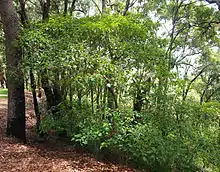Homalanthus nutans
Homalanthus nutans, known locally as the mamala tree, is a species of plant in the family Euphorbiaceae. In Australia it is known as the bleeding heart and the Queensland poplar.[3]
| Homalanthus nutans | |
|---|---|
 | |
| Scientific classification | |
| Kingdom: | Plantae |
| Clade: | Tracheophytes |
| Clade: | Angiosperms |
| Clade: | Eudicots |
| Clade: | Rosids |
| Order: | Malpighiales |
| Family: | Euphorbiaceae |
| Genus: | Homalanthus |
| Species: | H. nutans |
| Binomial name | |
| Homalanthus nutans | |
| Synonyms[2] | |
| |
Samoan healers use the tree's bark in a concoction made to treat hepatitis. Research has indicated that a chemical from the bark called prostratin has in vitro activity against HIV.[4]
Description
Homalanthus nutans is a small tree or bushy shrub up to 5 m (16 ft) tall. The trunk has fairly smooth, greyish-brown bark. The rather stout branches are green or reddish, and the twigs exude a white, milky sap when damaged. The alternately arranged leaves have a pair of small stipules at the base of the long petiole, which is often a reddish colour. The leaf blade is hairless, heart-shaped or triangular, 7 to 12 cm (3 to 5 in) long by 6 to 8 cm (2.4 to 3.1 in) wide, with a smooth, untoothed margin. The underside is often greyish and mature leaves turn red as they age. The inflorescence is a terminal yellowish-green spike, the male and female flowers being separate. The male flowers are small and petal-less, with globose anthers. The few female flowers, near the base of the spike, are also without petals, and have a pair of short styles. The female flowers are followed by capsules about 1 cm (0.4 in) long, with two compartments, the seeds being partially enclosed by a fleshy aril.[3]
Distribution and habitat
Homalanthus nutans is native to various tropical Pacific islands: the Caroline Islands, the Cook Islands, Fiji, New Caledonia, Niue, Samoa, the Society Islands, Tonga, Tubuai Island, Vanuatu and Wallis and Futuna.[2] It also grows in northeastern Australia, in Queensland and the coastal strip of New South Wales at altitudes of up to 500 m (1,600 ft).[3] The seeds have a long dormancy period, but germinate readily when the conditions are suitable, such as when the previously shady forest floor becomes illuminated by direct sunlight.[3] It is a pioneer species, found in woodland and on roadside verges, readily colonising disturbed ground.[5]
Ecology
The fruits of Homalanthus nutans are attractive to birds, including the brown cuckoo-dove, the silvereye, Lewin's honeyeater, bowerbirds and currawongs.[3] In Samoa, the plant has a number of uses in traditional medicine. An extract from the bark is used against hepatitis, and freshly crushed leaves are used to control bleeding.[3] Modern research confirms the plant's pharmacological activity, with the anti-HIV drug prostratin having been isolated from the plant.[6]
References
- Botanic Gardens Conservation International (BGCI) & IUCN SSC Global Tree Specialist Group (2018). "Homalanthus nutans". IUCN Red List of Threatened Species. 2018: e.T135882796A135882798. doi:10.2305/IUCN.UK.2018-2.RLTS.T135882796A135882798.en. Retrieved 29 October 2021.
- "Homalanthus nutans (G.Forst.) Guill". Plants of the World Online. Royal Botanic Gardens, Kew. Retrieved 8 October 2021.
- Simpson, Donald. "Homalanthus nutans (G.Forst.) Guill. 1837". Some Magnetic Island Plants. Retrieved 10 October 2021.
- Field, M. (2005). "Samoa forest holds secret of future drugs". Pacific Islands Report. Archived from the original on 14 March 2012. Retrieved 1 August 2011.
- "Flora profile: Bleeding heart". Land for Wildlife. 26 September 2016. Retrieved 10 October 2021.
- Cox, Paul Alan (1993). "Saving the ethnopharmacological heritage of Samoa". Journal of Ethnopharmacology. 38 (2–3): 177–180. doi:10.1016/0378-8741(93)90014-V. PMID 8510467.
